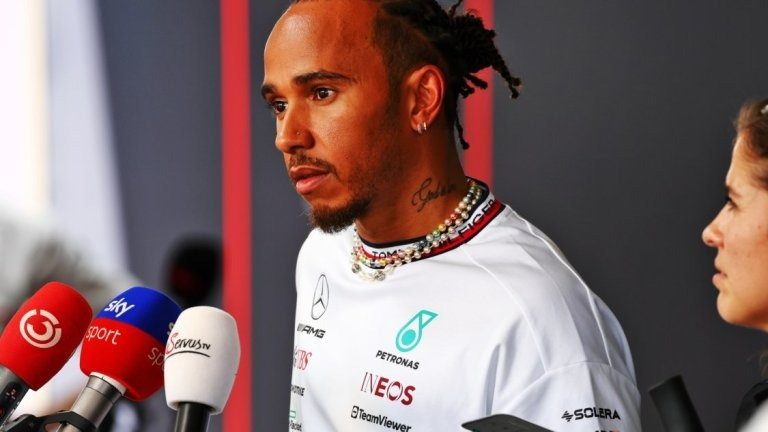Lewis Hamilton and Mercedes have faced significant challenges to their ability to compete at the top of the sport in the 2024 Formula One season. The seven-time world champion has openly criticised Pirelli’s tyres, claiming that they offer a narrow window for optimum performance.
However, Pirelli have responded to Hamilton’s accusations, claiming that tyres are not the main issue affecting performance.

Miami, a race to forget for Hamilton
Lewis Hamilton’s weekend at the Miami Grand Prix was a turbulent one, reflecting the inconsistent performance of the W15 car throughout the season. The seven-time world champion faced challenges from the outset, retiring from Sprint qualifying in the second half of the session.
In the sprint race itself, Hamilton dropped from P8 to P16 after receiving a 20-second penalty for speeding in the pit lane. He was also involved in a fierce battle with Kevin Magnussen’s Haas, with the Danish driver receiving four penalties.
Qualifying for the main race also proved difficult for Hamilton. Despite the struggles, Mercedes managed to improve their pace by making set-up changes between the Sprint and Grand Prix qualifying sessions. Hamilton put in a strong lap in Q2 to secure third place, but ultimately qualified P8 behind team-mate George Russell, losing over 0.4 seconds on his Q2 time in the final section
Hamilton’s bewilderment
Speaking after the session, Hamilton expressed his bewilderment at how the car had suddenly come alive in Q2. He was just 0.164 seconds slower than pace-setter Charles Leclerc. “I thought the first two sessions were generally better. Q2 was… the car suddenly felt mega in Q2 and then it disappeared in Q3. It’s the first time this year that it’s really worked in Q2, I would say.
Asked if he knew what had caused the loss of pace in Q3, Hamilton sadly replied, “We don’t know. We really, really don’t know and I couldn’t tell you, honestly…”
Tyres challenges
Throughout Friday and Saturday, the drivers struggled with overheating tyres and lack of grip. Hamilton was unsparing in his criticism of the current Pirelli tyres, recalling the wider operating window offered by Bridgestone tyres in the past.
“Q2 was the best the car felt and then in Q3 it just felt nowhere. We’re just working in a really tiny window of tyre performance. I can’t remember in my whole career having such a small window…”
Reflecting on the differences, Hamilton added: “You look back to the days when you had a much bigger window to work with, so you could just optimise the balance and then have good grip throughout the lap. I don’t know. It’s definitely… it’s definitely my least favourite”.
Pirelli’s rebuttal
In response to Hamilton’s criticism, Pirelli has defended its tyre design and performance. The Italian manufacturer argues that the competitive nature of modern Formula One, where the field is much closer, means that any small detail can affect performance. This increased level of competition can make the tyres seem less effective.
Simone Berra, Pirelli’s Formula 1 Chief Engineer, explains: “Every tyre has its maximum performance at a certain point in time and the working window is just a definition. We use a percentage of grip loss to define the window. That was the same in the past as it is now. Back then, this detail was not so important, but today it is very important”.
Influence of car characteristics
Berra goes on to explain that the characteristics of the cars themselves have a significant impact on the performance of the tyres.
“In the past, 15 or 20 years ago, we had cars that were 0.5 to 0.7 seconds apart, it wasn’t that close. Today it’s very different. Even a tenth of a second makes a big difference,” he continues. The design and set-up of the cars, including their suspension systems and how they interact with the tyres, play a crucial role in tyre performance.
“We know that the C4 and sometimes the C5 have a small performance peak at high temperatures,” adds Berra. “Some teams are less able to hit that window than others. It’s partly down to the tyres, but it’s also down to the car, the suspension and how the car is designed to get the tyre out on the track. So there are two factors.
Defining the tyre’s working window
Understanding the tyre’s working window is essential for optimum performance. Pirelli defines this window based on a maximum grip loss of three percent and the temperature required for peak performance. The closer riders can keep the tyres within this window, the better the overall grip and performance will be, which is particularly important in a tightly contested field.
Mario Isola, Pirelli’s Formula 1 boss, explains: “In motorsport, when the tyre is cold, it generally has little grip. The grip increases as the temperature rises. Then there is a maximum, a turning point. After that, the tyre overheats and loses grip again. This peak grip performance is what the teams strive for during a race.”
Isola adds: “When we reach the maximum in the corner, we define the three percent around it as a working window. We try to make the corner flatter and as wide as possible between these two points. This approach aims to provide a broader and more consistent performance plateau, giving the rider a wider working window.”
Bottom line
While Lewis Hamilton’s frustration with the Pirelli tyres is understandable, Pirelli’s explanation sheds light on the complexities of tyre performance in modern Formula 1. The tighter competition and the intricate interplay between car characteristics and tyre specifications mean that even small details can have a significant impact.
Pirelli’s efforts to provide a consistent and wide working window aim to balance these challenges, ultimately suggesting that tyres alone may not be the sole cause of performance differences.